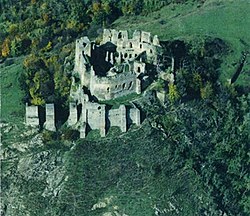Crișana is a historical-geographical region that today falls largely within the boundaries of Romania and only minimally inHungary.
To know
Crișana offers aspiring visitors a couple of cities (Arad is Oradea) with interesting architecture from the time of the Habsburg domination plus a series of smaller villages in the inland valleys still dominated by the ruins of medieval fortresses that had the function of controlling the trade routes of the time between the Pannonian plain and the Transylvania.
The star of the tourism of Crișana are the Apuseni mountains which with their magnificent high mountain landscapes constitute a pole of attraction for trekking enthusiasts, campers, winter sports enthusiasts or simply weekend hikers from Cluj-Napoca and other major cities ofHungary and of Romania. The Apuseni Mountains also offer a series of suggestive caves much visited and reported further on.
Finally, wine lovers might find interesting a visit to the wineries of Ghioroc, Păuliş and Covăsânț in the wine-growing region just east of the city of Arad where fine vintage wines are kept.
Geographical notes
Crișana is a name derived from the three tributaries of the Criș river (in Hungarian Körös) that arise in the Apuseni mountains and cross the region: Crișul Alb, Crișul Negru, Crișul Repede.
According to one theory, Crișana is perhaps related to the Greek term Χρυσός (golden) perhaps due to the gold particles present in the upper reaches of the three rivers or due to the blond color of their waters.
Crișana has as its natural boundaries the Tisza to the west, the Mureș River to the south which serves as a border with the Banat, the Apuseni Mountains to the east and the Someș River to the north. It is a hilly region located between the Pannonian plain to the west and the Apuseni Mountains to the east.
Background
Like the neighboring one Transylvania, Crișana was the object of the expansionist aims of the Hungarian sovereigns since the dawn of the 11th century. In the chronicles Gesta Hungarorum of "Anonimus" refers to the battles fought by the Hungarians against the local nobles of the neo-Latin language and tradition. The Ottoman domination alternated with the Hungarian dominion and from 1699 the Habsburg domination which lasted until the end of the First World War, after which most of the region was assigned to the Romania under the Treaty of Trianon of 4 June 1920.
Territories and tourist destinations
The Crișana region is roughly made up of the three present-day districts (județe) of:
Urban centers
- 1 Arad - Second regional center, Arad presents like Oradea a series of elegant architecture from the Habsburg era.
- 2 Beiuş - Quiet town that was a stronghold of the neo-Latin language and culture that resisted the Hungarian and German colonization.
- 3 Ghioroc - Village in the wine-growing region east of Arad where fine wines such as Pinot Noir and Cabernet are produced.
- 4 Jibou - There is one of the most interesting botanical gardens in Romania, the "Vasile Fati" located in the former estate of the Hungarian nobles Wesselényi.
- 5 Lipova - Town of 10,000 inhabitants with interesting architecture and a Turkish bazaar. Nearby are the imposing ruins of the Șoimoș fortress which guarded the traffic bound for Transylvania along the valley of the Mureș River.
- 6 Oradea - Greater center of Crișana, Oradea it is famous for its Baroque and Art Nouveau architecture, evidence of its centuries-old subjection to the Habsburg rule.
Other destinations
- 1 Băile Felix - Renowned spa whose establishments exploit hot springs that form a small lake.
- 2 Moneasa - Thermal station whose springs have been exploited since the second half of the 19th century for therapeutic purposes.
- 3 Padiş - Plateau of the Apuseni mountains which attracts trekking enthusiasts. It has numerous caves and canyons and is crossed by a myriad of streams. It can also be crossed by car along provincial roads largely paved but winding and narrow.
- 4 Porolissum - Quite well preserved ruins of a Roman castrum installed in 106 AD, during the Dacian-Roman wars of Trajan. The camp soon evolved into the city becoming the capital of the Roman province of Dacia Porolissensis in 124 AD.
- 5 Stâna de Vale (Biharfüred) - Small health resort in the green pastures of the Vlădeasa massif (Apuseni Mountains) at an altitude of 1100 meters and a spa center. There are also ski lifts that make up Stâna de Vale a busy destination for winter sports enthusiasts.
How to get
How to get around
What see


- 1 Cave of the Bear (Peștera Urșilor). Cave near the village of Chişcău, a short distance from the DC252 highway. It was discovered by chance in 1975 by a group of amateur speleologists. It owes its name to a bear fossil found inside, which lived 27,500 years ago and became extinct in the last ice age. The cave has three cavities joined by natural corridors.
- 2 Scărișoara cave (Peștera Scărișoara). Cavern of glacial origin with a vast hall of 120 X 720 m and other smaller ones joined to the main one by tunnels. Scărișoara Cave is located in the Apuseni Mountains at over 1,000m. of altitude and is considered the most beautiful of the Romania.
- 3 Bezdin Monastery (Mănăstirea Bezdin). Serbian Orthodox monastery from the 16th century on the right bank of the Mureș River, near the village of Munar. Visit the monastery church dedicated to the dormition of the Madonna (Biserica "Adormirea Maicii Domnului").
- 4 Hodos-Bodrog Monastery (Mănăstirea Hodoș-Bodrog). The oldest orthodox monastery of the Romania with a continuous monastic tradition.
- 5 Săvârșin Castle (Castelul Săvârșin). A manor house on a royal estate of 6.5 hectares. Confiscated by the Communists, the castle was returned after the year 2,000 to the former King Michael I of Romania (1921–2017).


